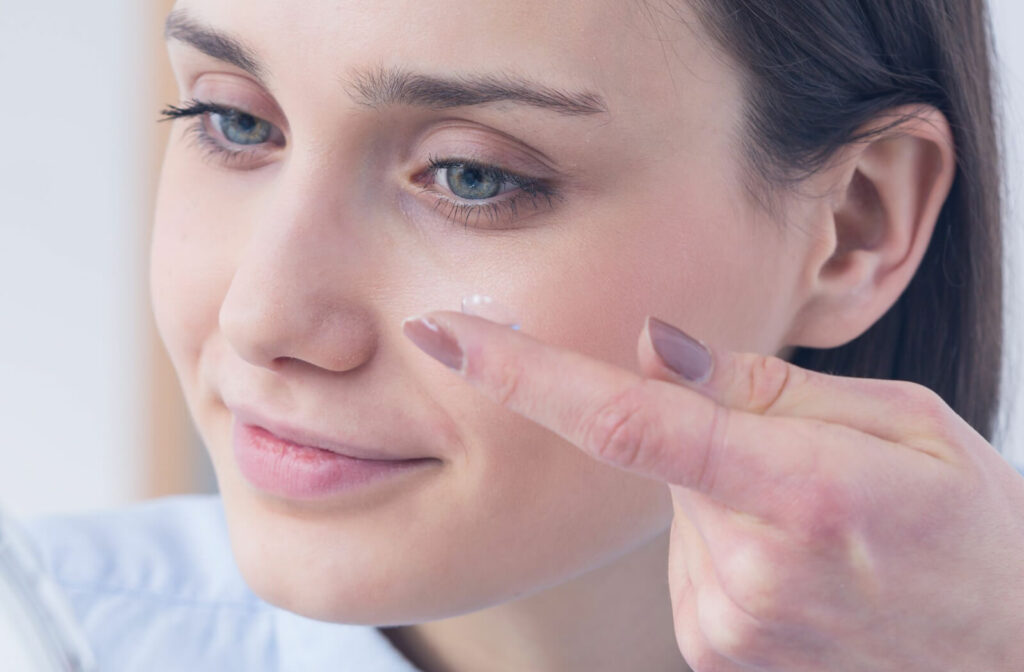For many people, contact lenses are preferable to eyeglasses. Contacts, after all, have a wider field of view, don’t obstruct your vision with frames, make some daily activities more convenient, and give you more options for non-prescription sunglasses. However, not everyone is a candidate for traditional contact lenses. Factors like your eye shape or eye health can make traditional contacts uncomfortable for you and make scleral lenses a better fit for you.
With advances in contact lens technology, some optometrists can offer a variety of specialty contact lenses that can treat specific ocular issues, such as scleral lenses. If you have dry eye syndrome or a corneal condition, such as keratoconus, scleral lenses may be the best option for achieving crisp, comfortable vision.
What Are Scleral Lenses?
Unlike a regular soft contact lens, which sits on the cornea, a scleral lens sits on the less-sensitive whites of your eyes, called the sclera.
Scleral lenses have a wider diameter than standard contacts, allowing them to vault over the cornea. This leaves a pocket that can be filled with a saline formula to keep your eyes hydrated throughout the day. These characteristics make scleral lenses a good option for those who suffer from uncomfortable dry eye symptoms.
Who Is a Candidate for Scleral Lenses?
An irregular-shaped cornea is one of the most significant things that makes someone a candidate for scleral lenses. However, it’s certainly not the only reason a person would wear these contact lenses. If you can’t achieve your desired vision results with eyeglasses or regular soft contact lenses, you may be considered a candidate.
Some of the ocular conditions that scleral lenses can treat include:
- Corneal transplant complications
- Dry eye syndrome
- Abnormal eyelids
- Keratoconus
- Stevens-Johnson Syndrome
- Complications from LASIK or radial keratotomy
Having one of these conditions doesn’t guarantee that scleral lenses will be a good fit for you, but it’s worth having a conversation with your eye doctor.
Benefits of Scleral Lenses
One significant benefit of a scleral lens is the surface area they cover. Because they’re larger, they’re less likely to move around or become dislodged from the eye. Typically, this lens also offers superior clarity and comfort because of its size.
Additionally, the pocket of liquid under the lens provides moisture and improved oxygen delivery for patients with dry eye syndrome. And this pocket of saline also promotes healing for those with eye surface diseases.
Types of Scleral Lenses
There are 3 main types of scleral lenses:
Full Scleral Lenses
These are the largest lenses available. Their primary use is for advanced keratoconus or severe dry eyes because they cover more of the eye and leave a larger pocket of fluid, offering more comfort.
Mini Scleral Lenses
These scleral lenses are still larger than standard soft contacts and still provide lots of space between the cornea and the contact lens by resting on the anterior sclera.
Corneoscleral and Semi–Scleral Lenses
Sometimes after LASIK or other refractive surgeries, contacts are still needed to correct astigmatism. In these cases, corneoscleral or semi-scleral lenses are potentially good options.
Disadvantages of Scleral Lenses
Because they require special training to fit and prescribe, not every optometrist or ophthalmologist can prescribe and fit scleral lenses. And even if your eye doctor can fit you with these lenses, scleral lenses are typically more expensive than a standard soft contact lens.
If you already wear soft contact lenses, switching to scleral lenses can be a big change because of their steeper learning curve. However, once you’re comfortable using scleral lenses, these specialty contacts are usually the more comfortable option.
Scleral Lenses vs. Soft Contact Lenses
The most notable difference between the 2 lens types is size. A traditional soft contact lens rests on the cornea, where the scleral lens extends to the sclera. Because of this, the scleral lens is generally more comfortable, especially for those with the conditions listed above.
Another significant difference is that a scleral lens can prevent hypoxic damage to the cornea caused by a lack of oxygen, which can happen when traditional contacts aren’t worn properly. The liquid-filled gap between the scleral lens and the eye promotes oxygen movement to the cornea.
Inserting Scleral Lenses
Not all the differences are convenient. For example, inserting a regular contact lens in your eye simply involves using a clean finger to place it on your eye. However, a scleral lens must be perched on 3 fingers, filled with a special solution, and placed carefully on the eye.
Caring for Your Lenses
There’s not much difference between the 2 types of lenses regarding their care. However, a scleral lens does need a special contact solution for cleaning and sterilizing. Other than that, the typical recommendations apply:
- Don’t sleep in your lenses.
- Only handle your lenses with clean hands.
- Avoid getting tap water on your lenses.
Discuss Your Contact Lens Options
If you’re not satisfied with your glasses and traditional soft contact lenses aren’t right for you, give us a shout at Optical Illusions. Our knowledgeable staff can answer your questions about scleral lenses and book you an appointment with one of our eye doctors.



